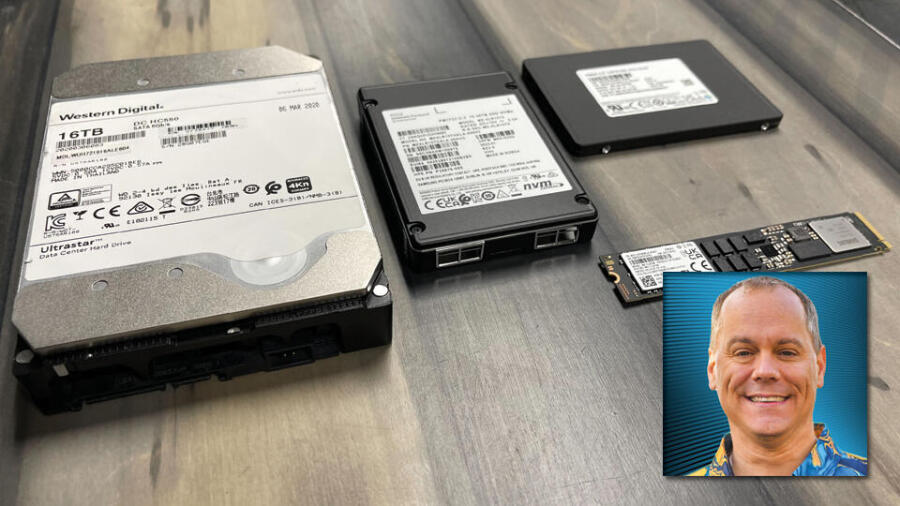While I typically steer clear of diving too deeply into the technical nitty-gritty, in this month’s column I’m making an exception, because there’s a technological evolution underway that has the potential to fundamentally enhance technical outcomes and, more importantly, grow revenue. This game-changer is Non-Volatile Memory Express (NVMe) storage.
NVMe stands to reshape the landscape of our industry, especially in its latest iteration with Peripheral Component Interconnect (PCI) 4.0. While this might all sound like incomprehensible tech jargon and acronyms, the implications are far-reaching and deeply relevant to us all. Let’s unpack why this innovation is a turning point — not just in technology, but in the potential it unlocks for our businesses and the broader industry community.
By investing in NVMe’s advanced technology, you’re not just enhancing performance; you’re also adopting a more cost-effective approach that can drive significant long-term savings for your business.
Delivering Content Quickly
Before I explain what a system “PCI bus” is, or how NVMe storage takes full advantage of it, let me explain why you should read the rest of this article.
Our livelihoods are based on delivering adult entertainment as fast as possible. At the core of all of those web pages, sexy pictures and videos is information stored on a server. Making all this possible and delivering a dynamic user experience requires accessing a database, which also lives on your storage devices.
A simple page might have to “ask” the database 10 queries, a content-rich page might send 20 to 60 queries and a complex page sometimes more than 100 queries to one or multiple databases — and all of this must happen before anything is displayed to your site visitor. Now, imagine how incredibly taxing this becomes when you have hundreds or thousands of simultaneous users and you need them all to see your page faster than you can snap your finger. The quality of the service you provide is going to depend heavily on the speed of your technology.
From Hard Disk and Solid-State Drives to NVMe
When it comes to storage types, you can think of spinning hard disk drives (HDDs) as providing speed comparable to that of a car. Solid-state drives (SSDs) are faster, like an airplane. But NVMe achieves rocket-like speeds, taking us all to Mars today, instead of decades from now with Musk or Bezos.
Most hosting involves a hybrid approach, with HDDs storing the largest content libraries and databases living on SSDs. If your content library is small, then perhaps everything is on SSDs, which is the most ideal setup using legacy technologies. This has been an effective and economical approach, serving us all well for the past decade. Most advanced users take advantage of content delivery network (CDN) solutions, which takes most of the video and picture-request load off the server and pushes it out to the edge of a global network of caching servers. This is amazingly effective, which is why I recommend CDN to everyone.
Whether you are using SSDs or HDDs, however, there is still a bottleneck. The server's processor (CPU) and memory (RAM) are in a constant wait for storage, with the CPU metaphorically tapping its foot, always awaiting content and database results to deliver through your Ethernet port and across the World Wide Web to your impatient surfer.
Picture it like this: The fire department arrives to tackle a blaze at your house, but instead of connecting the fire hose to a powerful hydrant, they hook it up to your ordinary garden tap. It won’t matter how good the hose is if your garden tap can only provide a limited water flow.
In this scenario, the server’s PCI system bus, which transfers data, is like the main water line. It connects all critical components, from storage to CPU, memory, and then to the ethernet port. When you use an HDD or SSD connected via a 300-MB/s (megabytes per second) SATA (Serial AT Attachment) connection in your server, the SATA connection caps data transfer at 300 MB/s. This limitation affects both HDDs and SSDs, creating that bottleneck and restricting how swiftly data can move through your server, much like how a garden tap limits the effectiveness of a fire hose in battling a roaring fire.
What you want instead is to tap into the full power of a high-pressure fire hydrant — PCI 4.0 NVMe. This technology isn’t just a step up; it’s a quantum leap, allowing data to flow at speeds far exceeding SATA limitations. With PCI 4.0 NVMe, you’re no longer constrained by the 300 MB/s cap. Instead, your data transfer rates can reach up to 7,000 MB/s or more. Unleashing this torrent represents a massive upgrade in performance and efficiency.
Input/Output Operations Per Second
But wait, there’s more! Wait for the punch line, and you’ll really understand why I thought it was so important to bore the heck out of you with technical details.
Let’s add IOPs (Input/Output Operations Per Second) into the firefighting analogy. Think of IOPs as the number of trips firefighters can make to extinguish a fire. Each trip represents one operation: either fetching water (reading data) or throwing it on the fire (writing data). The more trips they can make in a second, the faster the fire is extinguished.
- Standard Enterprise HDDs: Imagine firefighters using a bucket brigade. Each bucket passed along represents one IOP. With HDDs, this is like making around 80 to 160 trips per second. Since 1992, their speed has remained unchanged at 7,200 RPM (revolutions per minute). It’s steady and reliable for small fires, but is limited by the physical effort required to pass each bucket.
- Standard Enterprise SSDs: Now replace the bucket brigade with a motor-powered pump. This method is significantly more efficient; SSDs can handle about 3,000 to 40,000 IOPs. Just as the pump delivers a continuous flow of water, SSDs, free from mechanical constraints, can access and transfer data much faster.
- PCI 4.0 Enterprise NVMe: Finally, envision an advanced firefighting aircraft capable of dropping massive amounts of water. Thanks to the incredible speed and efficiency of this technology, PCI 4.0 NVMe can reach up to 1,000,000 IOPs or more. It’s like making a million trips per second, delivering an overwhelming amount of water in a fraction of the time.
In this analogy, the progression from the manual bucket brigade (HDDs) to a motor-powered pump (SSDs), and finally to an aerial firefighting approach (PCI 4.0 NVMe) vividly illustrates the dramatic increase in data handling capabilities. Each step up in technology allows for exponentially more “trips” to be made in a second, skyrocketing the speed of data transfer.
Investing in Game-Changing Lightning-Fast Speeds
Shifting to NVMe technology can be a game-changer for your online business, significantly impacting key areas like traffic conversion, customer retention and cost efficiency. In the digital era, speed is synonymous with success — and NVMe’s unparalleled data processing capabilities mean your website and applications run at lightning-fast speeds.
This means pages load almost instantaneously and transactions are smoother, which can substantially boost sales. This increase in speed can even give new life to old, poorly written and inefficient code, which often hurts page load times. Further, this improvement can lead to better search engine optimization (SEO) results, another crucial element for success in our industry.
Additionally, the sheer power and efficiency of NVMe allows for greater workload handling with fewer servers. This not only reduces the physical footprint of your data infrastructure, but also slashes operational costs like power and cooling.
Not All Structural Hardware Is Created Equal
When it comes to hardware component quality, many providers cut costs by using consumer-grade parts. These are cheaper, lag in performance and often struggle under heavy loads, leading to decreased performance and impacting your website’s reliability and user experience. Additionally, they lack essential features like memory error correction, which is vital for maintaining data integrity. Furthermore, such features as Power Loss Protection (PLP) are absent in consumer parts. PLP is crucial for preventing data loss or corruption during unexpected power outages. Lastly, the failure rates of consumer components are higher, posing a risk to the dependability of your hosting service, which can result in data loss.
We are at a pivotal moment. With the age-old bottleneck challenge of storage finally overcome, the focus now shifts to maximizing the efficiency of CPU, RAM and the system bus. If a host can harness AMD’s cutting-edge Ryzen and EPYC server technologies, which are designed to leverage the extraordinary capabilities of the PCI 5.0 bus, all the better. This leap forward goes beyond the already impressive PCI 4.0 NVMe storage, offering unparalleled data transfer speeds and extraordinary capacity. Advanced infrastructures like these are built for growth and scalability, effortlessly supporting up to 100 gigabits of throughput per hosting instance.
The choices before you are not just exciting but transformative. Capable hosts can now deliver the future to your doorstep. Regardless of your provider, it’s crucial to embrace these technological advancements to fuel the future of your business.
Brad Mitchell is the founder and president of MojoHost, which has served the industry for nearly two decades and has been named XBIZ Web Host of the Year several times. He regularly shares insights as a panelist at trade shows. Contact brad@mojohost.com to learn more about the suite of services his company offers.






